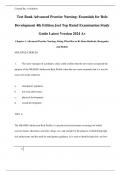Exam (elaborations)
Test Bank Advanced Practice Nursing: Essentials for Role Development 4th Edition Joel Top Rated Examination Study Guide Latest Version 2024 A+
- Course
- Institution
- Book
Test Bank Advanced Practice Nursing: Essentials for Role Development 4th Edition Joel Top Rated Examination Study Guide Latest Version 2024 A+ ..
[Show more]












